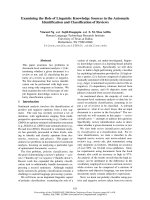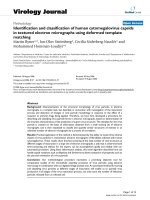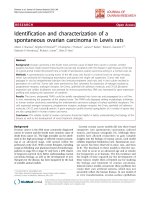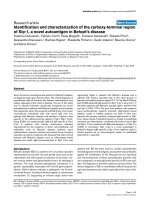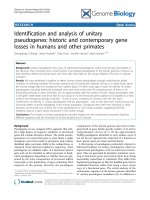Identification and prioritization of constraints in Umblachery breed cattle farming through participatory approach
Bạn đang xem bản rút gọn của tài liệu. Xem và tải ngay bản đầy đủ của tài liệu tại đây (242.18 KB, 11 trang )
Int.J.Curr.Microbiol.App.Sci (2018) 7(11): 1100-1110
International Journal of Current Microbiology and Applied Sciences
ISSN: 2319-7706 Volume 7 Number 11 (2018)
Journal homepage:
Original Research Article
/>
Identification and Prioritization of Constraints in Umblachery Breed Cattle
Farming Through Participatory Approach
M.S. Kannadhasan1*, M. Kathirchelvan2 and R. Rajendran3
1
Veterinary University Training and Research Centre, Tamil Nadu Veterinary Animal
Sciences University (TANUVAS), Dharmapuri – 636701, Tamil Nadu, India
2
Farmers Training Centre, TANUVAS, Tiruvarur-610 004, Tamil Nadu, India
3
Post Graduate Research Institute in Animal Sciences, TANUVAS, Kattupakkam – 603203,
Tamil Nadu, India
*Corresponding author
ABSTRACT
Keywords
Identification,
Prioritization,
Umblachery breed
cattle, Participatory
approach
Article Info
Accepted:
10 October 2018
Available Online:
10 November 2018
Umblachery cattle are well-known indigenous breed for its draught power in Cauvery
delta region. Conservation of Umblachery cattle breed gained importance in recent
years. In this background, the study with the financial assistance from Tamil Nadu
Veterinary and Animal Sciences University Research Corpus Fund (TRCF) was
conducted at Umblachery, a native village of Umblachery breed tract in Nagapattinam
district, Tamil Nadu to identify and prioritize the constraints in Umblachery breed
cattle farming faced by farmers through participatory approach. Thirty progressive
farmers in and around Umblachery village who were selected applying purposive
random sampling technique, participated in focused group discussion to identify the
constraints followed by personal interview to prioritize the constraints and group
discussion to find the possible reasons behind constraints. The entire participatory
method was carried out with the help of Department of Animal Husbandry, Tamil
Nadu and representatives of Non-Governmental Organizations (NGOs) and Famers’
association. Individually prioritized scores on the farmers’ identified 15 constraints
were subjected into Garrett ranking method to measure the significance. The results
revealed that the lack grazing land having highest Garrett table mean score of 79.37 as
the most important and serious constraint followed by improper maintenance of ponds
(72.30), feed deficit (59.30), mechanization (53.77), dominance of fertilizer (51.60),
inadequate farmers club (49.17), lack of bull (48.75), dominance of cross-bred animals
(43.56), lower price of animals and its products on sale (42.55), unregulated marketing
(39.44), lack of awareness about technologies (38.86), indiscriminate breeding
(34.06), record maintenance (32.66), natural disaster proneness (30.58) and deficit of
manpower (26.87). The results will foster the policy makers involved in Umblachery
cattle breed conservation to develop and implement appropriate strategies to overcome
the constraints in Umblachery breed cattle farming.
1100
Int.J.Curr.Microbiol.App.Sci (2018) 7(11): 1100-1110
Introduction
India is bestowed with rich domestic animal
biodiversity with 30 breeds of cattle, 10 breeds
of buffaloes, 42 breeds of sheep, 30 breeds of
goats, 8 breeds of camels, 6 breeds of horse
and 18 breeds of poultry in addition to other
species like pig, donkey, mithun, yak, turkey,
duck, etc. Genetic resources are the building
blocks of sustainable agriculture (Bishop et
al., 2002).
Tamil Nadu is the home of well-known
draught breeds of cattle, such as Kangayam,
Umblachery,
Bargur,
Alambadi
and
Pulikulam. Umblachery breed, also known by
the synonyms Mottai madu, Molai madu, Jathi
madu and Therkathi madu, is a reputed
draught breed of Thanjavur, Thiruvarur and
Nagapattinam districts in eastern parts of
Tamilnadu state in south India. This breed is
the outcome of selection for short stature,
suitable for work in marshy rice fields of
Cauvery deltaic region (Thangaraju et al.,
2001). Umblachery breed is noted for its
strength and sturdiness especially used in the
marshy fields for wet ploughing. The cows are
poor milkers. The white star on forehead,
white socks markings in four legs and white
tail switch are the specific characteristics of
this breed. The habitat of this breed is in the
Cauvery delta region, the rice granary of
Tamil Nadu. The breeding tract of this breed
has shrunken over the years. Intensive
agriculture with mechanization and the
dominance of exotic breeds and cross breeds
has reduced the role of indigenous cattle breed
(Taneja, 2011).
Genetic value of an animal is determined not
only due to its production, but also due to its
adaptability
to
existing
environment,
utilization of available feed resources and
particularly to the level of resistance to local
diseases (Radhika et al., 2010). It is difficult
to save them, unless they are made economical
under the prevailing production systems
(Choubey and Thomas, 2010). The United
Nations proclaimed the year 2010 to be the
International Year of Biodiversity, and people
all over the world are working to safeguard
this irreplaceable natural wealth and reduce
biodiversity loss. Hence, the major thrust in
draught
animal
welfare
should
be
improvement of the productivity of draught
animals through scientific and technological
inputs (Ramaswamy, 1994). A report of FAO
stated that the neglect of animal power
technology in recent years affected the
availability of essential information. In such
circumstances, participatory appraisal surveys
may be required to study the present uses of
work animals, the existing constraints and the
future potential.
Increasingly, the constraints to animal power
development are psychological or social rather
than technical or economic. These calls for an
immediate action for identifying and
prioritizing the constraints faced by the
farmers in Umblachery breed cattle farming.
Materials and Methods
The
study
was
conducted
through
participatory approach to identify the
constraints perceived by the farmers and how
are they in consonance with the perception of
farmers group. It was conducted at
Umblachery village, believed as the native
village of the breed in Nagappattinam district,
Tamil Nadu. Thirty progressive farmers who
are actively involved in Umblachery cattle
farming in and around Umblachery village
were identified and selected applying
purposive random sampling technique with
the help of Department of Animal Husbandry
and Traditional Umblachery Cattle Farmers’
Association. Purposive selection method was
followed to ease the application of
participatory methods in identification and
prioritization of the constraints perceived by
1101
Int.J.Curr.Microbiol.App.Sci (2018) 7(11): 1100-1110
the farmers Umblachery breed cattle farming.
Initially, a focused group discussion among
the farmers was conducted to identify the
constraints perceived by the farmers who are
rearing Umblachery breed cattle. Then,
personal interview was conducted with each
respondent to prioritize the constraints
perceived by him/her from the identified 15
constraints. The responses recorded from
respondents were simultaneously entered,
analysed and prioritized using Garrett ranking
calculation.
entire participatory method was carried out
among the farmers by encouraging them to
accomplish the participatory approach in the
presence and with the guidance of
Veterinarians from the Department of Animal
Husbandry, Tamil Nadu and representatives of
Non-Governmental Organizations (NGOs)
and Traditional Umblachery Cattle Farmers
Association.
Results and Discussion
Identification and grouping of constraints
Garrett ranking technique
Garrett ranking technique was used to rank the
constraints perceived based on its seriousness
and significance by farmers involved
Umblachery breed cattle farming. The order of
priority and severity of the constraints given
by the respondents was converted into ranks
by using following formula.
The focused group discussion among the
Umblachery breed cattle farmers revealed that
there were fifteen perceived constraints in
which each six constraints were grouped under
individual and social constraints and the
remaining three under constraints of both
individual and social as listed in Table 1.
Prioritizations of identified constraints
100 (Rij – 0.5)
Percentage position = ---------------------Nj
Where,
Rij = Rank given for the ith variable by jth
respondent
Nj = Number of variable ranked by j
respondent
th
With the help of Garrett’s table, the percent
position estimated is converted into scores.
Then for each constraint, the scores of each
individual are added and total value of scores
and mean values of score is calculated. The
constraint having highest mean value is
considered to be the most important constraint
Finally, a group discussion was conducted to
discuss the possible reasons behind the
prioritization of identified constraints. The
The results obtained subjecting the collected
response into Garrett ranking method showed
in Table 2 clearly envisaged that of the
identified constraints social constraints were
predominantly perceived as serious constraints
followed by constraints of individual and both.
An animal can be maintained in a
recommended manner by an individual. But,
conservation of an indigenous breed is in the
hands of community, government, research
institutions and NGOs. Though the
responsibility of breed conservation vests in
the hands of community, the progressive
change towards breed conservation should
originates at individual farmer level.
Further, the results revealed the importance of
community utilization of common resources
like grazing land and ponds which could be
achieved by Community Based Organizations
(CBOs) and Farmers club.
1102
Int.J.Curr.Microbiol.App.Sci (2018) 7(11): 1100-1110
Based on the perception of farmers, the
possible causes of prioritized constraints and
strategies to overcome such constraints were
discussed among the farmers and Subject
Matter Specialist (SMS) group. Besides this,
there are unfelt constraints also in Umblachery
cattle farming. Hence the discussion was
confined to farmers’ perceived constraints
only.
constraint, SMS group emphasized on
implementing community water resource
management practice through suitable
extension service. Further, it recommended
conducting periodical water quality test and
estimating the egg and worm load of parasites
in the ponds. They advocated the agencies
involved in breed conservation to sensitize the
farmers and trained to use the pond
sustainably.
Lack of grazing land
Feed deficit
The farmers stated that lack of grazing land is
the most severe constraint in Umblachery
breed cattle farming. Common grazing land
available has degraded and become less
productive due to encroachment and poor
maintenance.
National Livestock Policy, 2013 of
Government of India recommended that
physical availability and production potential
of pastures and grazing community lands have
to be assessed for defining steps to rejuvenate,
restore, improve and manage such lands by
planting fodder trees and grasses. SMS group
stated that it is the right time to encourage
integrated land use planning with livestock as
a component through gross-root level
institutions like Panchayat Raj Institutions
(PRI) will be beneficial. Further, there is a
need to adopt the practice of land use with
multiple crops in a sustainable manner.
Improper maintenance of ponds
In the villages of Umblachery cattle breed
tract, ponds are also a common property for
the whole rural community. Farmers worried
about maintenance of ponds since maintaining
exclusive ponds for livestock is still a subject
of dispute among the farmers and non-farming
community people. This paved way for lag in
maintenance of the ponds. Dwindling water
resources and declining rainfall every year are
making the situation worse. To overcome this
Farmers knew that providing feed to the
animals as such on the ground results in feed
and fodder wastage. Research revealed that
manger can save 30.00 per cent of fodder
wastage compared to providing fodder as such
on the ground. Farmers felt that the need of
concentrate feeding is least important since
they believed that Umblachery cattle can
tolerate extreme feed deficit.
They were presently developing their
awareness on importance of feed and fodder in
cattle ration due to various schemes including
“Fodder Minikit Scheme” of Animal
Husbadry and various field level extension
activities by Tamil Nadu Veterinary and
Animal Science University.
The breeding tract of Umblachery breed cattle
is the rice granary of Tamil Nadu. Complete
utilization of agriculture residues and byproducts for feeding cattle can economize the
use of available feed and fodder.
Hence, it is beneficial to promote agriculture
by-products and waste as animal feed by
enriching the proven technologies like
treatment of straw with Urea and molasses
along with silage. The ability of the
Umblachery cattle to tolerate feed deficit
should not be taken into lighter sense. Quddus
(2010) found that crisis feed leads to reduction
in native animals.
1103
Int.J.Curr.Microbiol.App.Sci (2018) 7(11): 1100-1110
Mechanization
Inadequate farmers club
In the group discussion, farmers revealed that
the rapid mechanization in agriculture
operation challenges the use and existence of
draught animal. Farmers who are keeping
Umblachery breed cattle know that animal
power is generally affordable and accessible to
small and marginal farmers and experience
that use of native animals carries economic
and sentimental value well beyond the farm
gate. An average bullock is rated at 0.4-0.5 HP
and a 35 HP tractor is, therefore, supposed to
replace at least 70 bullocks. Contrastingly,
draught animals replace the agriculture
machinery run on fossil-fuel (Dikshit and
Birthal, 2010).
Farmers emphasized the role of community
based conservation in Umblachery cattle breed
conservation. They stated that farmers’ club
and community based organizations meant for
Umblachery cattle breed conservation can
play a liaison role and evacuate the lag in
conservation efforts. Presently, an association
called, “Traditional Umblachery Cattle
Farmers’ Association” is actively functioning
Umblachery village of Nagapattinam district
and Korukkai village of Thiruvarur district in
Tamil Nadu.
Farmers admitted that they preferred tractor in
the place of Umblachery bullock for
agriculture operations due to less involvement
of cost and time in hiring the service of
tractor. But, studies showed that individual
tractor ownership is seldom profitable for
small and marginal farmers but only for the
large farmers. Hence, there is need for
intensifying the social and basic scientific
research relating to work animals.
Though there are functioning farmers club and
Self Help Groups in the Umblachery breed
cattle prevalent villages, exclusive farmers’
association intensifies the concerted efforts in
promotion and improvement in breed
conservation. Further, farmers possessing pure
animals should come forward and recognize
themselves to form breeder clubs, with direct
link with the institutes involved in breed
conservation.
Government
departments,
NGOs, State agriculture and veterinary
universities involved in breed conservation
should encourage and support the farmer to
such cubs and associations.
Dominance of fertilizer
Lack of bull
Farmers agreed that use of fertilizers is
increasing to enhance the agriculture
production in the recent decades. However,
they agreed that they were aware of heavy use
of commercial fertilizer pollutes the
environment when they carried beyond the
agro-ecosystem.
Weeds often reduce crop yields by 10.00 per
cent or more which are more often controlled
by mechanical tilling of the soil and the use of
chemical methods (Pimentel et al., 1991).
However, the energy inputs for the herbicides
production are included; tillage turns out to be
less energy-intensive (Clements et al., 1995).
Farmers expressed their dissatisfaction on lack
of bull which has potential to cause adverse
effect in breed conservation. They justified
that they were unable to maintain pure bull
owing to the cost involved in maintenance and
suggested the Government to take the
responsibility of maintaining and supply of
pure bulls for breeding purpose in the breed
conservation mission. In this regard, State
Animal Husbandry and its exclusive Livestock
farm to conserve Umblachery breed in
Korukkai village of Thiruvarur district, Tamil
Nadu Veterinary and Animal Sciences
University and NGOs should accelerate its
1104
Int.J.Curr.Microbiol.App.Sci (2018) 7(11): 1100-1110
cooperative and coordinated efforts in breed
conservation.
products prepared from Umblachery breed
cattle which paves way to various
entrepreneurial avenues for farmers.
Dominance of cross-bred population
Unregulated marketing
Farmers pointed out the indigenous cattle were
preferred over crossbred due to their superior
adaptability to local environmental stresses,
rearing ease, low input and lesser proneness to
disease (Quddus, 2010). Considering the
production characteristics of cross-bred dairy
animals, the tendency of maintaining crossbred animals by farmers is in increasing trend.
Increase in cross-bred population competes
with Umblachery breed cattle for common
resource like grazing land, pond etc. It
questions the existing relationship among the
native breed farmers and cross-bred animal
farmers. A native breed should not be
considered as uneconomical based on its
production
parameters
alone.
The
sustainability and potential of native animals
have to be considered. Farmers are rearing
their native animals with the sentimental and
cultural value.
Lower price of animals and its products on
sale
Though the farmers felt proud of the
popularity and premium status given to the
milk and milk products prepared from
Umblachery cattle among the Cauvery delta
people, they were unsatisfactory on the price
given to their animals and its products. They
expected to fetch a premium price for the
products prepared from Umblachery breed
cattle as like organic farm products.
Considering the beneficial effect of
consuming milk products prepared from
native cattle milk, the consumers have to be
sensitized to worth-pay a premium price for
such products by suitable awareness and
promotional activities. Like the tremendous
response received by consumers on organic
farm products, there is a promising scope for
Farmers knew the importance of market in
selling any products to the consumer. They
showed their dissatisfaction experienced due
to unregulated market and constraints faced
while marketing their animals and its
products. There is no regulated market facility
for Umblachery cattle farmers except few
shandies
viz.,
Senbagarayanallur
of
Nagappattinam district and Thiruthuraippondi
of Thiruvarur district. Farmers, largely,
unaware of the value of their animals since
they have limited access to information
regarding markets. Regulation in marketing,
shortening the marketing channel, removing
the role of middleman and developing market
intelligence among farmers will augment this
condition.
Lack of awareness about technologies
Farmers believed that Umblachery breed in
disease resistant and less input-intensive. The
livestock farming activities are traditional in
nature without challenging the agro-ecosystem
and environment. Hence, they felt it was not
required to adopt new technologies and
restricted them to existing practices except
few practices viz., deworming, vaccination and
Artificial Insemination (AI). Lack of
awareness about technologies developed in
cattle farming was perceived as constraints
and come under the least important third part
of the prioritized constraints. Institutes and
departments involved in breed conservation
should carefully consider this belief to make
them aware and adopt the farmer-friendly
technologies developed to improve the
profitability of native cattle farming like
balanced ration, concentrate feeding, mineral
supplementation, manger etc.
1105
Int.J.Curr.Microbiol.App.Sci (2018) 7(11): 1100-1110
Strategies for Umblachery cattle breed conservation
Conceptual model
Society / community
Farmers
(Individual)
Knowledge
Attitude
Skill
CBO /
Farmers
club
Field staff
Community breed conservation
Sustainable use of common resources
Recommended management practices
Due consideration of real value of the animal
Market facilities
Breed development programme
Overcoming the unfelt constraints
Transformation from actual to desirable
Extension
service
1106
Int.J.Curr.Microbiol.App.Sci (2018) 7(11): 1100-1110
Table.1 Identification and grouping of constraints in Umblachery breed cattle farming
Individual constraints
1.
Mechanization
2.
Dominance of fertilizer
3.
Dominance of cross-bred animals
4.
Lack of awareness about
technologies
5.
Indiscriminate breeding
6.
Record maintenance
6
Social constraints
1.
Lack grazing land
2.
Improper maintenance of ponds
3.
Inadequate farmers club
4.
Lower price of animals and its
products on sale
5.
Unregulated marketing
6.
Natural disaster proneness
6
Totally 15 constraints
Both individual and
social constraints
1.
Feed deficit
2.
Lack of bull
3.
Deficit of
manpower
3
Table.2 Prioritizations of identified constraints in Umblachery breed cattle farming
Rank
I
II
III
IV
V
VI
VII
VIII
IX
X
XI
XII
XIII
XIV
XV
Constraints
Lack of grazing land
Social
Improper maintenance of ponds
Social
Feed deficit
Both individual and social
Mechanization
Individual
Dominance of fertilizer
Individual
Inadequate farmers club
Social
Lack of bull
Both individual and social
Dominance of cross-bred animals
Individual
Lower price of animals and its
Social
products on sale
Unregulated marketing
Social
Lack of awareness about technologies Individual
Indiscriminate breeding
Individual
Record maintenance
Individual
Natural disaster proneness
Social
Deficit of manpower
Both individual and social
Indiscriminate breeding
Tamil
Nadu
State
breeding policy
recommends Artificial Insemination (AI) in
Umblachery breed cattle using Umblachery
breed semen. However, preference of natural
service by the farmers and lack of bull
availability predisposes to indiscriminate
breeding. Kidai, a traditional practice
followed in Umblachery cattle rearing
villages in which herd men collect and group
(n=30)
Garret mean score
79.37
72.30
59.30
53.77
51.60
49.17
48.75
43.56
42.55
39.44
38.86
34.06
32.66
30.58
26.87
the Umblachery cattle from the in and around
village farmers and maintain in the harvested
agricultural land during off-season for
maintenance. In kidai, the practice of
maintaining bull enables the animals in heat
to become pregnant.
Herd men are unable to maintain pure breed
bull because of the cost involved in its
maintenance and its dwindling population.
These predisposes to indiscriminate breeding.
1107
Int.J.Curr.Microbiol.App.Sci (2018) 7(11): 1100-1110
Promoting the traditional practice of
maintaining kidai and providing quality bull
to herder can avoid indiscriminate breeding.
Practicing kidai requires proper herd
management practices especially herd health
management practices to minimize the healthoriented risk of keeping animals in group.
Record maintenance
Farmers felt that maintaining records is
difficult for them since grazing and water
requirement for keeping their animals involve
common use of communal grazing land and
ponds. Further, the benefits derived from
Umblachery breed cattle farming are not
always tangible. The practice of maintaining
record should be inculcated among the
farmers by sensitizing them about importance
of record maintenance and training them to
estimate the input cost involved while using
common resources and benefit gained in the
intangible form.
unemployment problem. Farmers felt that the
syndrome of manpower deficit is spreading
into the agriculture and animal husbandry
activities in recent decades. It could be due to
the improved educational status and the
attitude towards better standard of living
developed among the people. Hence, the gap
between availability of manpower and
unemployment problem in rural has to be
studied and suitable measures should be
implemented to break this paradox.
The above constraints identified by the
Umblachery breed cattle farmers were in line
with the findings of Quddus (2010).
Methodological approach in conservation
of Umblachery cattle breed
The constraints in Umblachery breed cattle
farming perceived by farmers have to be
overcome in order to conserve the breed from
genetic erosion. In this process, following
methodological approach will be helpful.
Natural disaster proneness
The native tract of Umblachery cattle is prone
for natural disaster like flood, drought and
tsunami. Considering the existence of farmers
under continuous risk of such natural disaster
every year and the activeness and sturdy
nature of Umblachery breed, farmers felt it a
less severe constraint. Further, they expressed
their satisfaction on the war-footing service
rendered by State Animal Husbandry and its
peer departments and Tamil Nadu Veterinary
and Animal Sciences University through its
peripheral centres to livestock farmers by
protecting and rescuing the livestock during
disaster.
Farmer-friendly information and technologies
through extension service
Capacity building of the famer in practices
like water resource management
Breed improvement after identification and
evaluation
Improving access
genetic material
to
suitably improved
Development and value addition of products
to fetch premium price
Regulated market and sale
Deficit of manpower
Strengthening farmer-consumer linkage
Farmers conveyed their feeling of ambiguity
about the paradoxical phenomenon existing
between
deficit
of
manpower
and
Improving access to local, regional, national
and international market
1108
Int.J.Curr.Microbiol.App.Sci (2018) 7(11): 1100-1110
Effective veldt management and animal
husbandry
Strenuous efforts in achieving coordinated
and cooperative efforts among farmers
Inculcating the conservation attitude among
the students
The declining indigenous cattle genetic
resource day by day leads to genetic erosion.
Withdrawal and decline in indigenous cattle
is, no doubt, an incredible loss to rural
livelihood and traditional agriculture. The
value of native cattle should not be measured
based on its production characteristics.
Farmers rearing Umblachery breed cattle
consider their animal as a source livelihood
besides the existing sentimental and cultural
attachment. Constraints prioritized
in
Umblachery cattle breed farming reiterates
the importance of community people and their
co-operation and co-ordination in breed
conservation. Hence, steps have to be taken to
encourage such community organization.
Hence, it is the need of the hour to develop
and implement prudent strategies to overcome
the prioritized constraints identified through
participatory approach for conservation of
Umblachery cattle breed. In this mission,
cooperative and coordinated efforts among
the farmers and agencies involved have to be
developed and intensified by strengthening
the extension service.
Acknowledgement
The authors bestow their immense gratitude
to Tamil Nadu Veterinary and Animal
Sciences University (TANUVAS) for
granting financial assistance and Directorate
of Research, TANUVAS for motivation and
concrete support. Equally, the authors extend
their gratitude to “Umblachery Cattle
Breeders
Association”,
Umblachery,
Department
of
Animal
Husbandry,
Nagapattinam and Department of Veterinary
and Animal Husbandry Extension Education
(VAHEE), Madras Veterinary College
(MVC), Chennai. Appreciation goes to Dr. N.
Vimal Rajkumar, Assistant Professor,
VAHEE, MVC, Chennai for his help at field.
References
Bishop, S.C., DeJong, H. and Gray, D. 2002.
Opportunities for incorporating genetic
elements into the management of farm
animal
diseases:
Policy
issues.
Commission on Genetic Resources for
Food and Agriculture, FAO, Rome. pp:
36.
Choubey, P. and Thomas, E. 2010. Native
breeds of Madhya Pradesh: An
overview, Proceedings of National
Conference on Native Livestock Breeds
and their sustainable uses, Vechur
Conservation Trust, Kerala, 27 and 28
September 2010, pp: 34-39.
Dikshit, A.K. and Birthal, P.S. (2010).
Environmental value of draught
animals: Saving of fossil-fuel and
prevention of greenhouse gas emission,
Agri. Econ. Res. Rev., Volume: 23,
July-December, 2010, pp: 227-232.
Quddus, M.A. and Amin, M.R. (2010).
Constraints of native cattle genetic
resource conservation and features of
breeding system in representative areas
of Bangladesh, Journal of Bangladesh
Agriculture University, Vol.: 8(1), pp:
113-120.
Radhika,
G.,
Raghavan,
K.C.
and
Reghunandanan, K.V. (2010). Role of
conservation of farm animal genetic
resources in disease management of
livestock, COVAS, Mannuthy, pp: 6469.
Ramaswamy, N.S. 1994 Draught animals and
welfare Rev. sci. tech. Off. int. Epiz.,
1994,13 (1), Pp. 195-216.
1109
Int.J.Curr.Microbiol.App.Sci (2018) 7(11): 1100-1110
Taneja, V.K. (2011). Report of the working
group on animal husbandry & dairying
12th Five Year Plan (2012-17),
Submitted to Planning Commission
Government of India, New Delhi.
Thangaraju, P., Nainar, A.M. and R.
Rajendran, 2001. Umblachery - A
renowned draught cattle of tamilnadu.
Proceedings of the Workshop on
Indigenous Cattle and Their Role in the
New Millennium, March 24-25, 2001,
Erode, Tamilnadu, India, Pp. 13-19.
How to cite this article:
Kannadhasan, M.S., M. Kathirchelvan and Rajendran, R. 2018. Identification and Prioritization
of Constraints in Umblachery Breed Cattle Farming Through Participatory Approach.
Int.J.Curr.Microbiol.App.Sci. 7(11): 1100-1110. doi: />
1110

